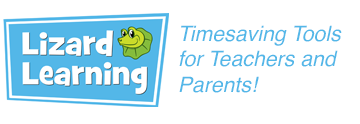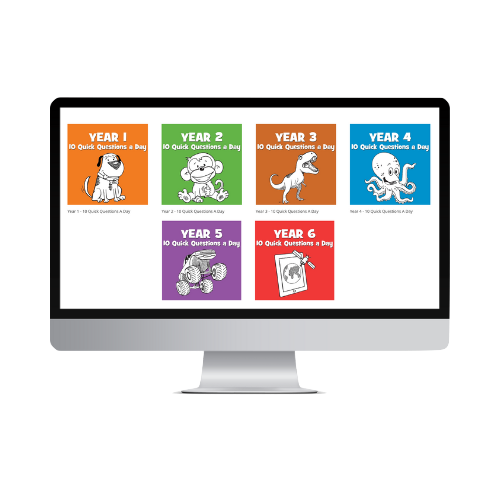Unlock Your Students’ Full Potential with Our Powerful and Effortless Literacy and Numeracy Daily Review Resources!
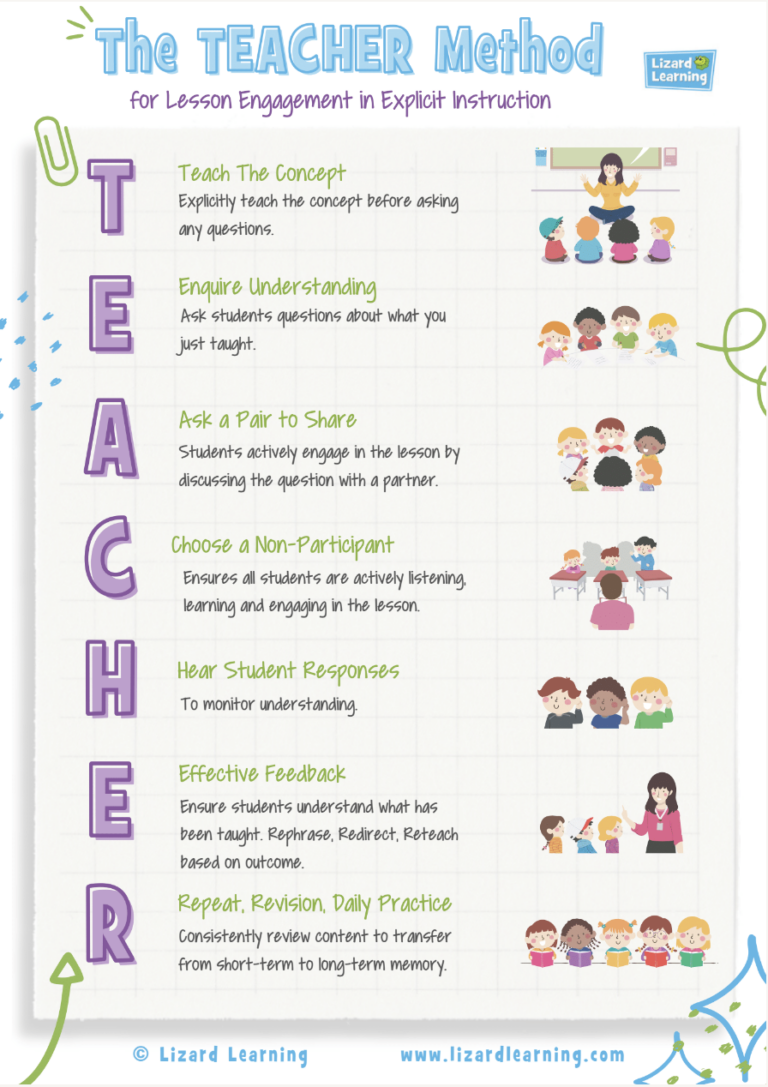
The Teacher Method Poster
Send download link to:
10 Quick Questions a Day PROGRAM
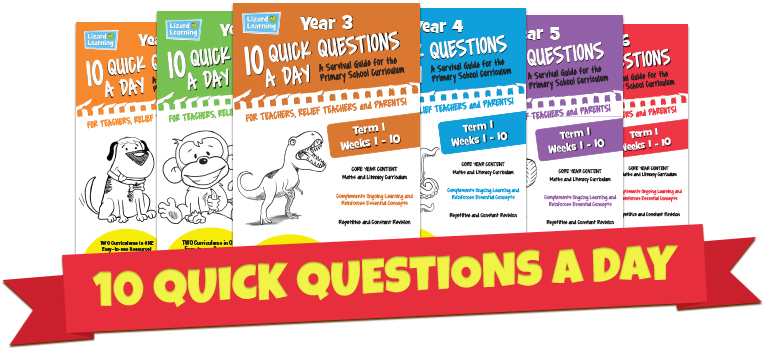
Get the resources kids LOVE and stop the hassle of constantly creating curriculum!
Why does the 10 Quick Questions a Day program create confident and successful learners?
The content includes 40 WEEKS of literacy and numeracy content.
The easy design of the program ensures your daily teaching instruction provides daily PRACTICE, PRACTICE, PRACTICE that science proves students need to learn effectively.
The program involves the method of SPACED practice which means we included multiple learning sessions every week (daily in the case of the 10 Quick Questions a Day program). Each session is short, concise and to the point.
We created the program using the method of INTERLEAVING >>> A process where students mix, or interleave, multiple subjects (over 10 curriculum areas each day when you use the program) or topics while they study in order to improve their learning.
The program was created for teachers to ensure their daily teaching plan consists of 10 Quick Questions a Day get positive learning outcomes!
(Each purchase covers one licence for up to 30 students)
We truly understand the immense challenges educators face in the ever-evolving landscape of curriculum development, all while juggling numerous teaching responsibilities.
We know creating daily reviews that gets results can be overwhelming, leaving you feeling stressed and on the brink of burnout.
Join the countless satisfied educators who have already transformed their teaching experience with our results-driven (and fun) resources!
Time-saving Tools for Teachers
How will the 10 Quick Questions a Day Program help my students in the classroom or my children in their home learning space?
It can be used as your homework program allowing more time for classroom daily planning instead of your spare time spent preparing page after page of homework sheets. The fundamentals in TWO curriculum have been done for you. Parents can view the daily work taught in the classroom and can be involved in their child’s learning.

What Does 10 Quick Questions A Day Include?
Planned-For-You daily revision, review, repetition, practice and consolidation teaching content
The only consistent daily program ensuring teachers have a reliable and easy-to-use daily revision system in place
5 Literacy and 5 Numeracy questions every day for 40 weeks
Over 2000 questions per year level ~ Years 1 to 6
2 Curriculum areas covered every day – Punctuation, spelling, writing, grammar, sentence, structure, time, number, chance + data, measurement, position/space and problem solving!! Answers included for easy marking
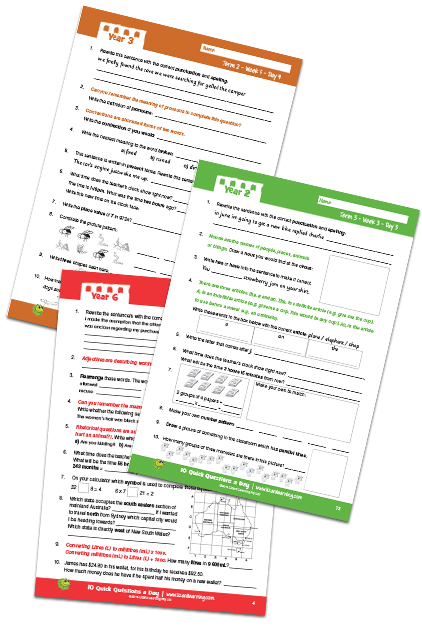
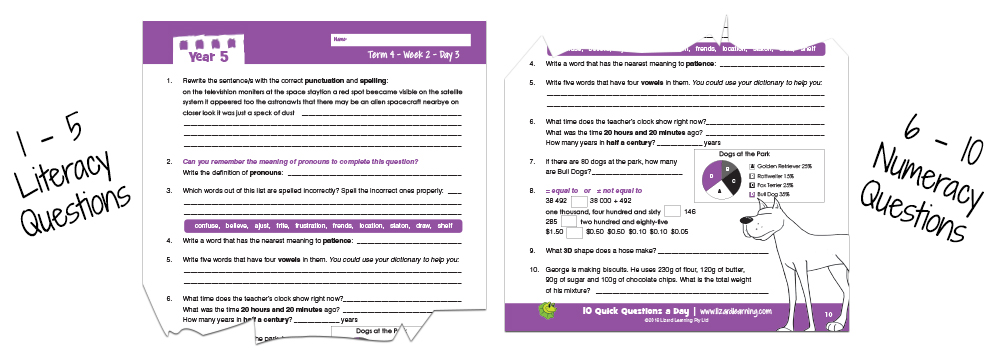
What Your Investment Provides:
A done for you daily review teaching content for TWO curriculum areas.
Gain your weekends and personal time back with a time saver program for each term.
Confidence to be guaranteed your students are learning through the principles of Science of Learning every day.
A 10 Quick Questions a Day lifetime licence for your classroom.
Ten hours saved in planning each week, that's 100 hours over a term, because the content is done-for-you already.
Peace of mind your teaching methods are providing the most effective way for your students to learn that is fun, engaging and creating results.
Ensures your daily teaching plan involves consistency in teaching content, revision, review, consolidation and practice.
The system is user-friendly, set out in a step by step process.
How it Works!!
1. Simply click the link below to purchase your 10 Quick Questions a Day program. This digital licence for each book you purchase and can be used for up to 30 kids in your classroom.
2. Download the program. Easy to use PDF format!!! Print copies for your classroom students or use on your pdf-compatible classroom device.
3. Enjoy watching your students thrive and working on their daily 10 questions every day – They will LOVE IT! !
(Each purchase covers one licence for up to 30 students)


Don’t Just Take Our Word For It!
Thousands of teachers are starting their day with 10 Quick Questions a Day DAILY REVIEWS to guarantee their teaching instruction includes daily practice revision, reteaching, review and consolidation of concepts taught yesterday, last week and last month.
In these two videos Teaching from the Heart and Mrs Lazar show how the 10 Quick Questions a Day program gives them:
✔️ Time back in their teacher planning
✔️ Ensures they are covering two curriculum areas every day
✔️ Display the multitude of uses the program provides to their teaching day
MAKING CURRICULUM EASY FOR TEACHERS!
10 Quick Questions a Day Program
Includes 10 curriculum areas which takes a quick 20 mins each day to explicitly teach.
Covers over 2000 LITERACY + NUMERACY questions for an entire year.
Ensures DAILY + GUIDED reviewing, practising, revising and consolidating of your teaching content each day.
Identifies gaps in learning fast giving you PEACE OF MIND knowing you are jumping onto any learning issues quickly for every student.
Based on the SCIENCE OF LEARNING ~ Spaced Learning, Interleaving, Explicit and Guided Instruction methods to your teaching plan. Your principal will be impressed!
Don’t be the only one not implementing daily reviews in your teaching plan – 1000’s of teachers across Australia start their morning ensuring they are covering all the fundamental basics for their students – Feel confident your teaching instruction will get your students the results they deserve.
Includes daily questions for every term across every year level, from Years 1-6. Purchase an entire term for only $75 on a lifetime licence to use with future students.
Or set and forget your DAILY REVIEWS and know they are ready for delivery every day of the school year. Purchase the whole year at a DISCOUNTED RATE
Kids LOVE Their Daily 10 Questions ~ What Teacher Doesn’t Want That?!
OTHER COOL RESOURCES KIDS LOVE!!
BOOTCAMP: Punctuation and Spelling
Our unique BOOTCAMP resource!!
25 daily questions to kick start and support revision in punctuation and spelling.
A concise 6 week fun bootcamp style format will have kids exercising and laughing on every page.
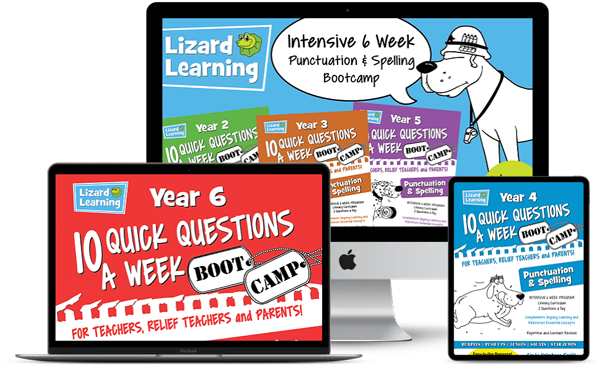
Early years – prep
Super fun and educational activities to engage any little learner. These sample pages introduce pre-literacy and pre-numeracy skills taught in the early years classroom.

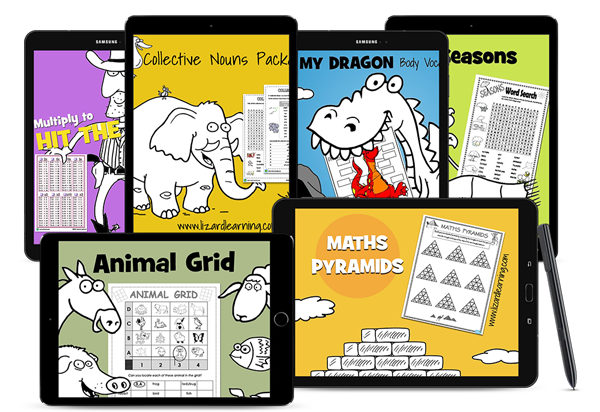
Colouring and Puzzle Pages
15 minute filler and fast finisher colouring and brain teaser activities.
Children will love working through these fabulous colouring and puzzle sample activities.
With an appealing layout ready for instant engagement, each page is designed to provide absorbing enjoyment and satisfaction.
Ideal as an additional education alternative, as a bonus for fast finishers, whole-class reward challenges, or for just about any time a bran workout is required.
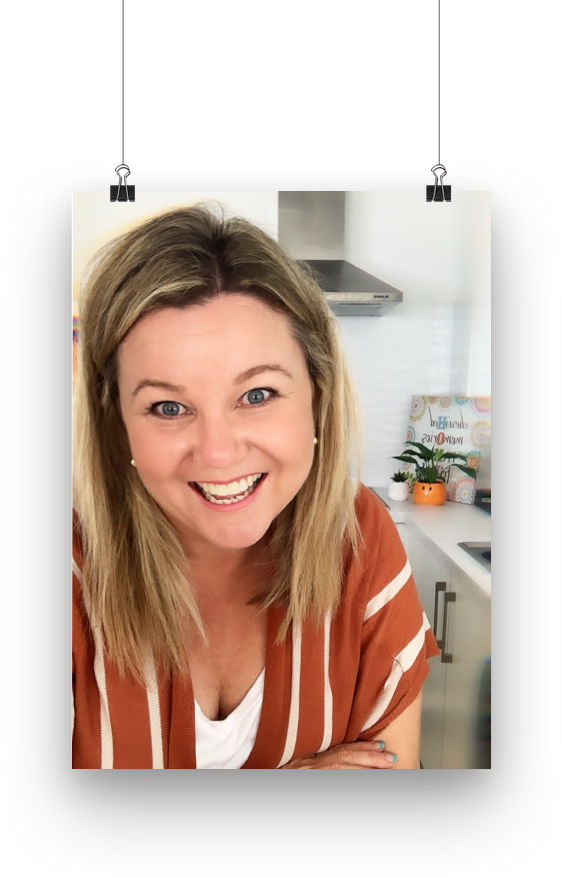
About Lizard Learning
So I began on my journey of creating an exciting and unique brand new set of resources for primary school teachers.
I spent considerable time bringing together a team of teaching professionals to ensure we created a useful and worthwhile teaching tool for students that catered to the fundamentals of literacy and numeracy based on the Australian Curriculum.

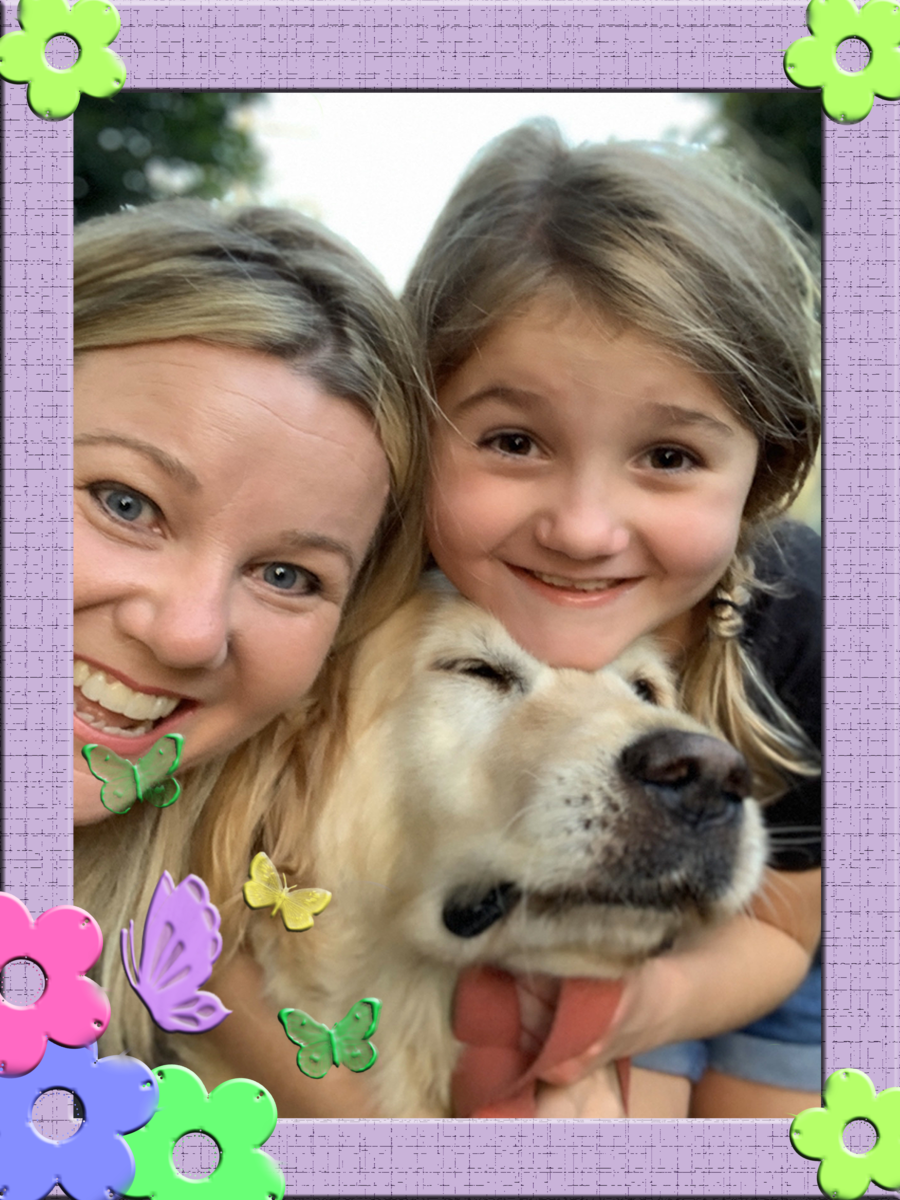
It was in this research and development phase that we discovered our users needed resources quickly. As a response to this, we have made our products available online for easy and instant accessibility at home and in the classroom.
We also understand that as a parent, it’s difficult to be involved in your children’s learning as schooling today is so different and can create many obstacles when you don’t have the required teaching knowledge to help with success.
Our flagship series,10 Quick Questions a Day can help overcome these hurdles in a one-step, easy-to-use resource. It’s not intended to replace the curriculum teaching, but to complement it by reinforcing the most essential concepts.
As a dedicated teaching tool, 10 Quick Questions a Day program covers 5 literacy and 5 numeracy questions a day, 5 days a week, for each term.
Lizard Learning, with our talented, energised and motivated team, look forward to developing quality teaching tools and resources from teachers for teachers, to respond to real educational and learning needs which will help you gain your precious family time back, yet create activities that will actually make a difference to all primary students.
Please drop me an email and share anything that is on your mind. I will always respond to any questions, suggestions or feedback.
Until next time, my fellow teachers, and educators remember, you are the ones who shape our World. Feel blessed you are part of such an important and rewarding profession!
This is for you if you:
✔️ Wish to increase your student’s learning easily and effectively to gain results fast, using principles backed by research from the Science of Learning
✔️ Need a DAILY REVIEW resource that you don’t have to spend hours planning that includes BOTH literacy and numeracy in your students daily revision and practice
✔️ Would like to see the gaps in learning fast without continual testing, assessment and marking. You will see where students are struggling instantly, when 10 Quick Questions a Day daily reviews are implemented each day
✔️ Crave a consistent approach to daily revision that will give your students positive learning outcomes
✔️ Want to be free from the overwhelm and stress of too much to do and not enough hours in the day
FAQ
I would like my school to pay. How does this work?
Perfect! Many schools do this so teachers don’t have to pay out of their pocket. If you love any of our resources, let your principal, deputy or head of curriculum know the resource and they can order the hardcopy version for each student on the school’s book list.
Can a homeschooling family use Lizard Learning resources?
We have 1000’s of homeschooling families using our resources. The 10 Quick Questions a Day program is a lifesaver for many families who need daily review of content and unsure of what to teach or cover for each year level.
Are your resources copyright protected?
Yes! We take copyright very seriously at Lizard Learning. There are many ways to purchase our resources without breaching copyright. If you are a teacher buying for the class, there is a class price on the website. Further, provide your school admin with the books you would like purchased and have them included on the book list so each child has their own hardcopy.
Can we order the hardcopy books via your website?
Yes! When you contact cindy@lizardlearning.com, we can provide you with a further school discount when you order hardcopy resources for your whole school. It’s a massive saving, giving money back to your school to be able to purchase further great teaching tools for their students.
Can I use 10 Quick Questions a Day Program if I am a teacher overseas?
Definitely! The questions are designed as a template. If you need to swap out some questions, for example, Q7 includes money and Q8 includes measurement. These would be the only questions you might need to swap to suit your school’s curriculum if you teach in another country.
I loved this Masterclass. Would you come to our school and present this as a PD?
Sharing these 5 easy strategies to make life easy for teachers to empower their teacher life is the greatest privilege owning an educational publishing provides. Please email cindy@lizardlearning.com and we can discuss presenting this as a PD to your teachers either in person or on a Zoom.
